
Princeton University is a private Ivy League research university in Princeton, New Jersey. Founded in 1746 in Elizabeth as the College of New Jersey, Princeton is the fourth-oldest institution of higher education in the United States and one of the nine colonial colleges chartered before the American Revolution. The institution moved to Newark in 1747, and then to its current campus, nine years later. It officially became a university in 1896 and was subsequently renamed Princeton University.
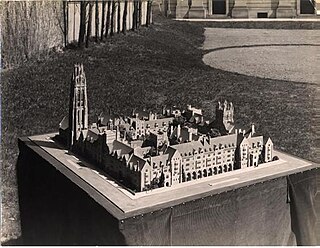
The Memorial Quadrangle is a residential quadrangle at Yale University in New Haven, Connecticut. Commissioned in 1917 to supply much-needed student housing for Yale College, it was Yale's first Collegiate Gothic building and its first project by James Gamble Rogers, who later designed ten other major buildings for the university. The Quadrangle has been occupied by Saybrook College and Branford College, two of the original ten residential colleges at Yale. The collegiate system of Yale University was largely inspired by the Oxbridge model of residential and teaching colleges at the University of Oxford and the University of Cambridge in the UK.

Collegiate Gothic is an architectural style subgenre of Gothic Revival architecture, popular in the late-19th and early-20th centuries for college and high school buildings in the United States and Canada, and to a certain extent Europe. A form of historicist architecture, it took its inspiration from English Tudor and Gothic buildings. It has returned in the 21st century in the form of prominent new buildings at schools and universities including Cornell, Princeton, Washington University, and Yale.

Jonathan Edwards College is a residential college at Yale University. It is named for theologian and minister Jonathan Edwards, a 1720 graduate of Yale College. JE's residential quadrangle was the first to be completed in Yale's residential college system, and was opened to undergraduates in 1933.

With 12,500 residents, New York University has the 7th largest university housing system in the United States, the largest among private schools.

Mathey College is one of seven residential colleges at Princeton University. Located in the Northwest corner of the Princeton Campus, its dormitories and other buildings are predominantly in the Collegiate Gothic style. Since the fall of 2007, Mathey has been a four-year residential college, paired with Rockefeller College.
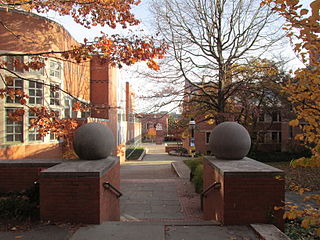
Lee D. Butler College is one of the seven residential colleges of Princeton University, founded in 1983. It houses about 500 freshmen and sophomores, 100 juniors and seniors, 10 Resident Graduate Students, a faculty member in residence, as well as a small number of upperclass Residential College Advisors. Butler is a four-year college, paired with the former First College. This means juniors and seniors are permitted to live in Butler, with priority for housing given to undergraduates who spent their first two years in either Butler or First.

Aurora University (AU) is a private university in Aurora, Illinois, United States. In addition to its main campus, AU offers programs online and at its George Williams College campus in Williams Bay, Wisconsin. Approximately 6,200 students are enrolled in bachelor's, master's, and doctoral degree programs at Aurora University.

First College, the first of Princeton University's six residential colleges, was developed in the late 1950s when a group of students formed the Woodrow Wilson Lodge as an alternative to the eating clubs. The Woodrow Wilson Lodge members originally met and dined in Madison Hall, which is now part of John D. Rockefeller III College. Inspired by the ideas of Woodrow Wilson, president of Princeton from 1902–1910, the members advocated a more thorough integration of academic, social and residential life on campus.
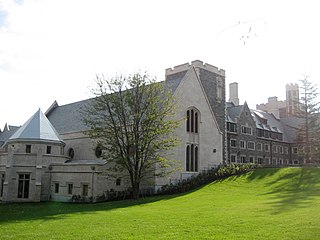
Whitman College is one of seven residential colleges at Princeton University, New Jersey, United States. The college is named after Meg Whitman, a former CEO of eBay, who donated $30 million to build the college. The structures were designed by the architect Demetri Porphyrios, the winner of the 2004 Driehaus Prize. Whitman College was completed in the fall of 2007, and first occupied during the 2007–08 academic year.
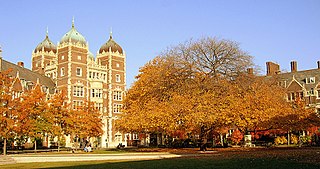
Cope and Stewardson (1885–1912) was a Philadelphia architecture firm founded by Walter Cope and John Stewardson, and best known for its Collegiate Gothic building and campus designs. Cope and Stewardson established the firm in 1885, and were joined by John's brother Emlyn in 1887. It went on to become one of the most influential and prolific firms of the late-nineteenth and early-twentieth centuries. They made formative additions to the campuses of Bryn Mawr College, Princeton University, the University of Pennsylvania, and Washington University in St. Louis. They also designed nine cottages and an administrative building at the Sleighton School, which showed their adaptability to other styles, because their buildings here were Colonial Revival with Federal influences. In 1912, the firm was succeeded by Stewardson and Page formed by Emlyn Stewardson and George Bispham Page.
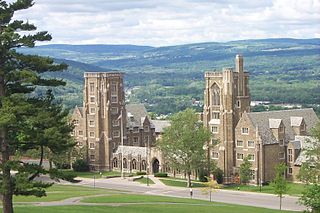
West Campus is a residential section of Cornell University's Ithaca, New York campus. As defined by the 2008 Master Plan, it is bounded roughly by Fall Creek gorge to the north, West Avenue and Libe Slope to the east, Cascadilla gorge and the Ithaca City Cemetery to the south, and University Avenue and Lake Street to the west. It now primarily houses transfer students, second year students, and upperclassmen.
Washington University in St. Louis has varied programs and events for students.

The Danforth Campus is the main campus at Washington University in St. Louis. Formerly known as the Hilltop Campus, it was officially dedicated as the Danforth Campus on September 17, 2006, in honor of William H. Danforth, the 13th chancellor of the university, the Danforth family and the Danforth Foundation. Distinguished by its collegiate gothic architecture, the 169-acre (0.68 km2) campus lies at the western boundary of Forest Park, partially in the City of St. Louis. Most of the campus is in a small enclave of unincorporated St. Louis County, while all the campus area south of Forsyth Boulevard is in suburban Clayton. Immediately to the north across Forest Park Parkway is University City.
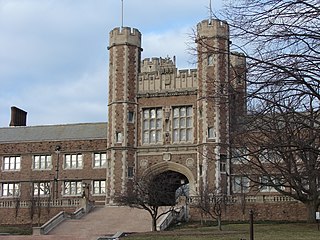
Brookings Hall is a Collegiate Gothic landmark on the campus of Washington University in St. Louis. The building, first named "University Hall", was built between 1900 and 1902 and served as the administrative center for the 1904 World's Fair. The first cornerstone was laid on November 3, 1900.
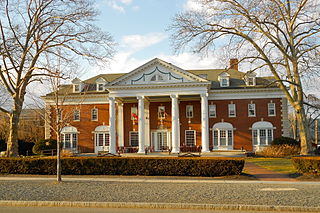
The eating clubs at Princeton University are private institutions resembling both dining halls and social houses, where the majority of Princeton undergraduate upperclassmen eat their meals. Each eating club occupies a large mansion on Prospect Avenue, one of the main roads that runs through the Princeton campus, with the exception of Terrace Club which is just around the corner on Washington Road. This area is known to students colloquially as "The Street". Princeton's eating clubs are the primary setting in F. Scott Fitzgerald's 1920 debut novel, This Side of Paradise, and the clubs appeared prominently in the 2004 novel The Rule of Four.
There are currently 33 undergraduate residence halls at the University of Notre Dame, including 32 active residence halls and Zahm Hall, which serves as a transition dorm when residence halls undergo construction. Several of the halls are historic buildings which are listed on the National Register of Historic Places. Each residence hall is single-sex, with 17 all-male residence halls and 15 all-female residence halls. Notre Dame residence halls feature a mixed residential college and house system, where residence halls are the center of the student life and some academic teaching; most students stay at the same hall for most of their undergraduate studies. Each hall has its own traditions, events, mascot, sports teams, shield, motto, and dorm pride. The university also hosts Old College, an undergraduate residence for students preparing for the priesthood.
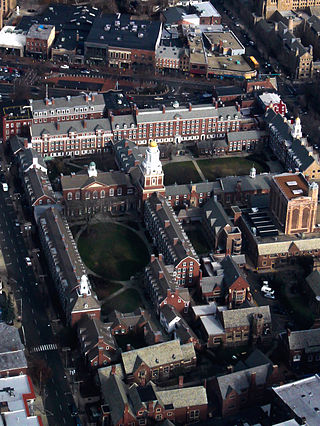
Yale University has a system of fourteen residential colleges with which all Yale undergraduate students and many faculty are affiliated. Inaugurated in 1933, the college system is considered the defining feature of undergraduate life at Yale College, and the residential colleges serve as the residence halls and social hubs for most undergraduates. Construction and programming for eight of the original ten colleges were funded by educational philanthropist Edward S. Harkness. Yale was, along with Harvard, one of the first universities in the United States to establish a residential college system.

Housing at the University of Chicago includes seven residence halls that are divided into 48 houses. Each house has an average of 70 students. Freshmen and sophomores must live on-campus. Limited on-campus housing is available to juniors and seniors. The university operates 28 apartment buildings near campus for graduate students.
The history of college campuses in the United States begins in 1636 with the founding of Harvard College in Cambridge, Massachusetts, then known as New Towne. Early colonial colleges, which included not only Harvard, but also College of William & Mary, Yale University and The College of New Jersey, were modeled after equivalent English and Scottish institutions, but American establishments gradually split with their forebears, both physically and academically.



















